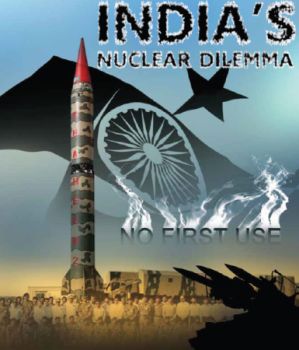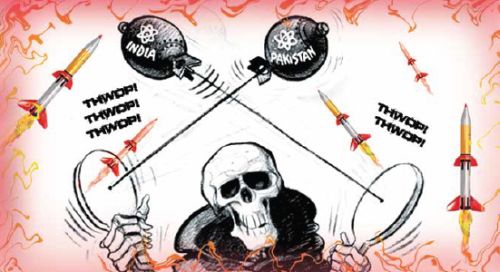A highly cerebral former Vice Chief of the Army reflects upon the recent introduction of Nasr Tactical Nuclear Missiles by the Pak Army. He feels this constitutes a paradigm shift which calls for a rethinking of our nuclear and conventional warfighting Doctrines. Pakistan has enough land based missiles to carry out such a first strike by launching Tactical Nuclear Weapons, either as a demonstrative one or on a tactical target to inflict sufficient damage to own troops and concentrations which are purely military in nature and thus be termed as Counter Troop. In all likelihood such a strike would be on Indian soil but be termed as defensive. He feels that the current Indian doctrinal position of a full fledged Indian counter value response to such tactical nuclear use may not be viable. He recommends instead a matching response with own tactical warheads which will enable own conventional offensives to proceed apace.
This article is published with the kind permission of “Defence and Security Alert (DSA) Magazine” New Delhi-India
 |
In May 1998 India and Pakistan carried out nuclear explosions in their respective countries and in the face of great opprobrium of many countries declared themselves as new ‘nuclear weapon’ powers. Soon the think tanks of both countries started their deliberations to evolve nuclear doctrines suited to their strategic needs. India declared a policy of NO FIRST USE while Pakistan made no such commitment and remained ambiguous, with a stated position that India has a much larger conventional force and could overwhelm Pakistan Forces in a conventional war; hence Pakistan may / will resort to FIRST USE if needed. This in essence implied that India will not use nuclear weapons first but if the other side chose to do so India will retaliate fully to the extent necessary. Both sides since then steadily built up their nuclear stockpile and today by some educated estimates Pakistan has much larger a nuclear arsenal than India and in fact has emerged as the fifth largest country behind USA, Russia, China and France.
This concept or doctrine remained valid till such time both sides had strategic nuclear weapons of large yields, ranging upwards of 20 Kiloton and above. This also meant that such weapons will essentially be COUNTER VALUE because of the inevitable collateral damage and not likely to remain confined to COUNTER FORCE. With induction of Tactical Nuclear Weapons however by Pakistan, there is a paradigm shift which needs to be articulated.
Tactical nuclear weapon refers to a weapon designed to be used in battlefield in a military situation as opposed to Strategic Weapons which are designed to menace large population. In other words, the former is meant to be used primarily against enemy forces while the latter counter value, meant for targets which may include civilian objectives like population centres. Tactical nuclear weapons were a large part of World’s nuclear stockpile during the Cold War and still constitute a sizeable number with USA and Russia and perhaps others.
A sizeable group of strategic thinkers maintain that THERE IS NO SUCH THING AS A TACTICAL NUCLEAR WEAPON because once a nuclear weapon has been launched by any side regardless of its size and yield it is “open season” thereafter and the adversary is free to use its strategic weapons in a counter value mode
It was Robert Mc Namara, the great strategic American thinker and once The Defence Secretary of USA who first articulated the concept of counter force strategy publicly in 1962 when he said that “Complete destruction of cities etc. would ultimately lead to a Mutually Assured Destruction situation. Instead cities can be held hostages; to destroy them at the outset was to sacrifice their principal value as object of leverage against the enemy. If War comes, USA will destroy enemy’s military forces and not his civilian population.” This concept led to the development of tactical nuclear weapons which enabled the power using them to confine the proposed strike to enemy troops and material without a risk of major collateral damage to civilian population.
Use of tactical nuclear weapons can be Counterforce or Demonstrative to show the will and determination of the user to use larger yield nuclear weapons against strategic targets if necessary. The deploying of tactical nuclear weapons is however fraught with risk of escalation quickly, particularly with the side having no self-imposed restrain of NO FIRST USE. Suspicion of the adversary’s intention can lead to an early launch of a weapon because of the syndrome of -“He thinks, we think, he thinks we think; he thinks we will attack, so he thinks we shall: SO WE MUST”. It is further accentuated if the releasing authority is delegated to subordinate commanders instead of being retained in the hands of a central authority.
A sizeable group of strategic thinkers maintain that THERE IS NO SUCH THING AS A TACTICAL NUCLEAR WEAPON because once a nuclear weapon has been launched by any side regardless of its size and yield it is “open season” thereafter and the adversary is free to use its strategic weapons in a counter value mode. The discussion has gone on not only in India but in many of the advanced countries having nuclear weapons where many subscribe to the idea that tactical nuclear weapons have no place in the dialectics of nuclear weapons. The writer does NOT subscribe to this with any degree of conviction.
 |
Pakistan nuclear doctrine
Now let us look briefly at Pakistan nuclear arsenal. By some guesstimate Pakistan has approximately 90 to 120 warheads with adequate number of delivery systems in the shape of aircraft and different varieties of nuclear capable missiles including the latest Shaheen I and Shaheen II. Besides they have developed / been gifted cruise missiles Babur and Raad which are nuclear capable. With enhanced capacity of production of weapon grade plutonium they are in a position to add four to six warheads every year to their stockpile. To these the latest vector which has been added is a Tactical Missile System Nasr which Pakistan claims is nuclear capable. This missile has been tested during a recent exercise by Pak forces. Obviously this also implies that they have in all likelihood, carried out miniaturisation of the nuclear systems to be fitted into The Nasr Missile which are claimed to be highly mobile and vehicle mounted. Further, because of its comparatively smaller size and mobility would be easy to conceal which becomes vital in today’s battlefield which is becoming more and more transparent. This system, purely by definition would fall in the category of tactical nuclear weapon.
Pakistan has stated without any ambiguity that their nuclear arsenal is solely India specific. Further they have repeatedly emphasised that they will resort to nuclear weapons should their core interests be threatened which include a number of parameters of space, survival of military forces and economic blockade.

 von
von 


